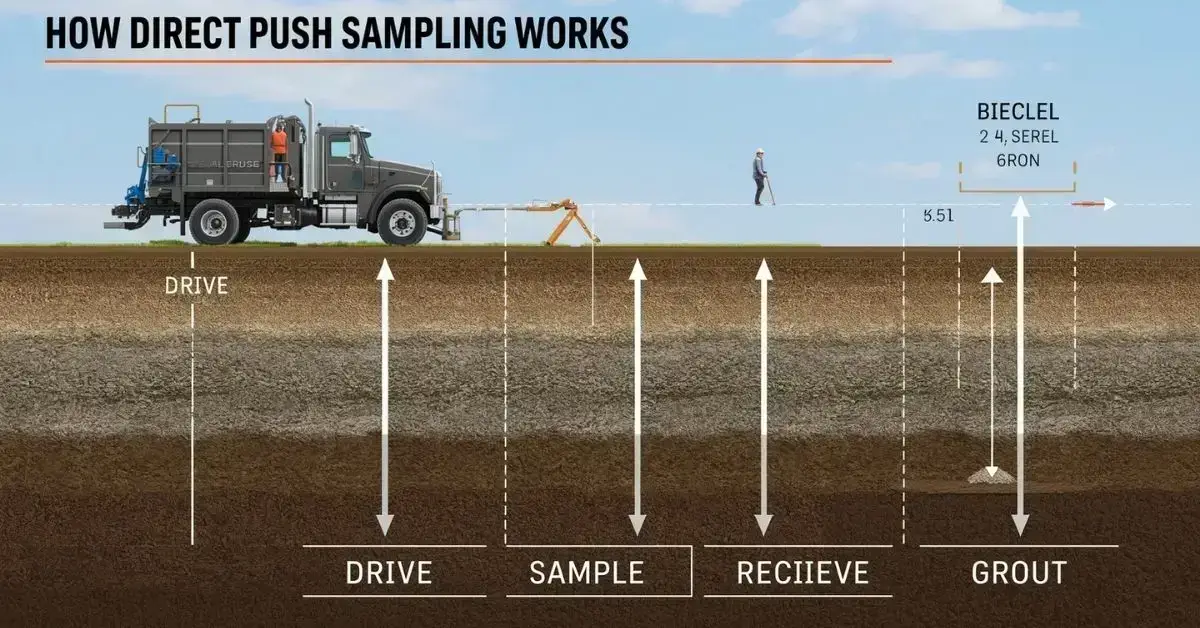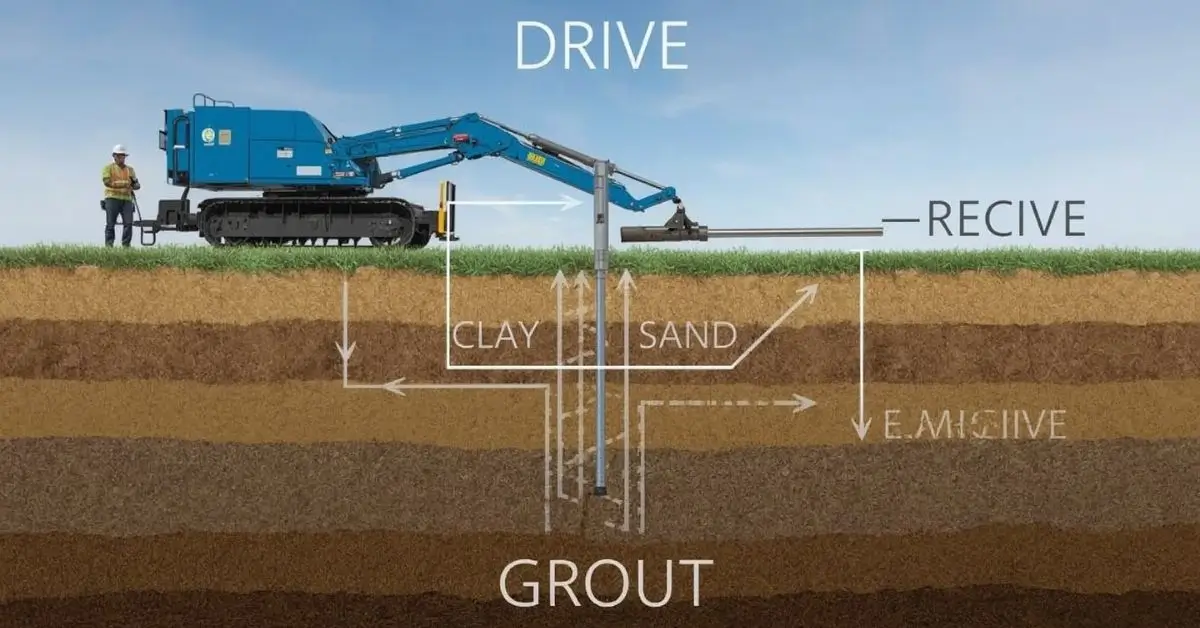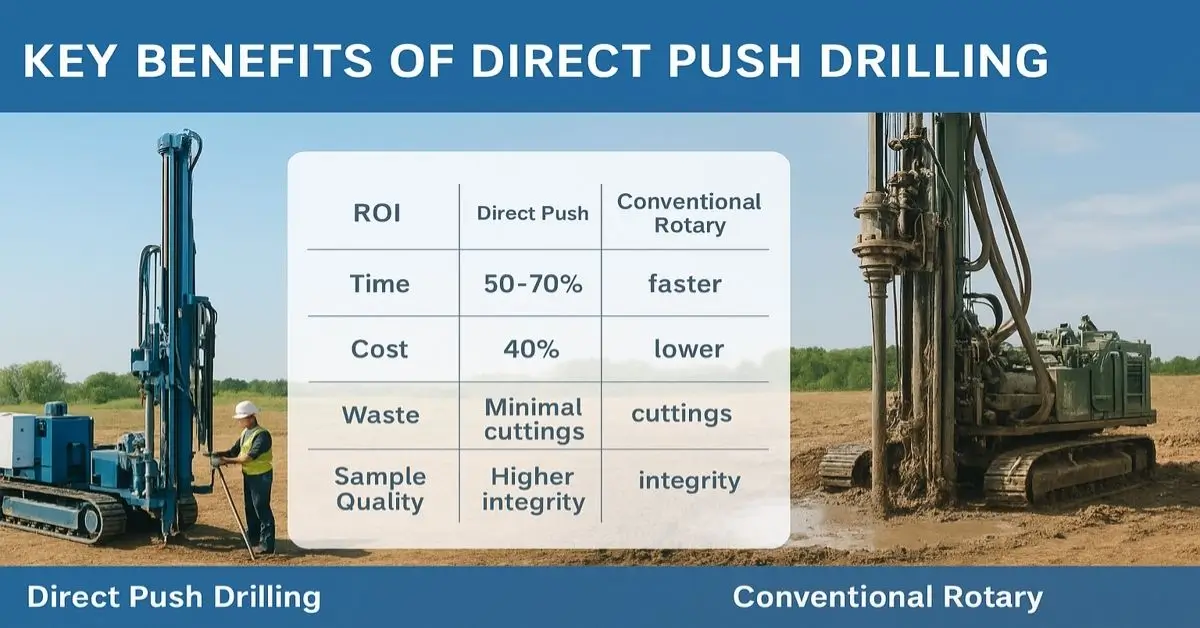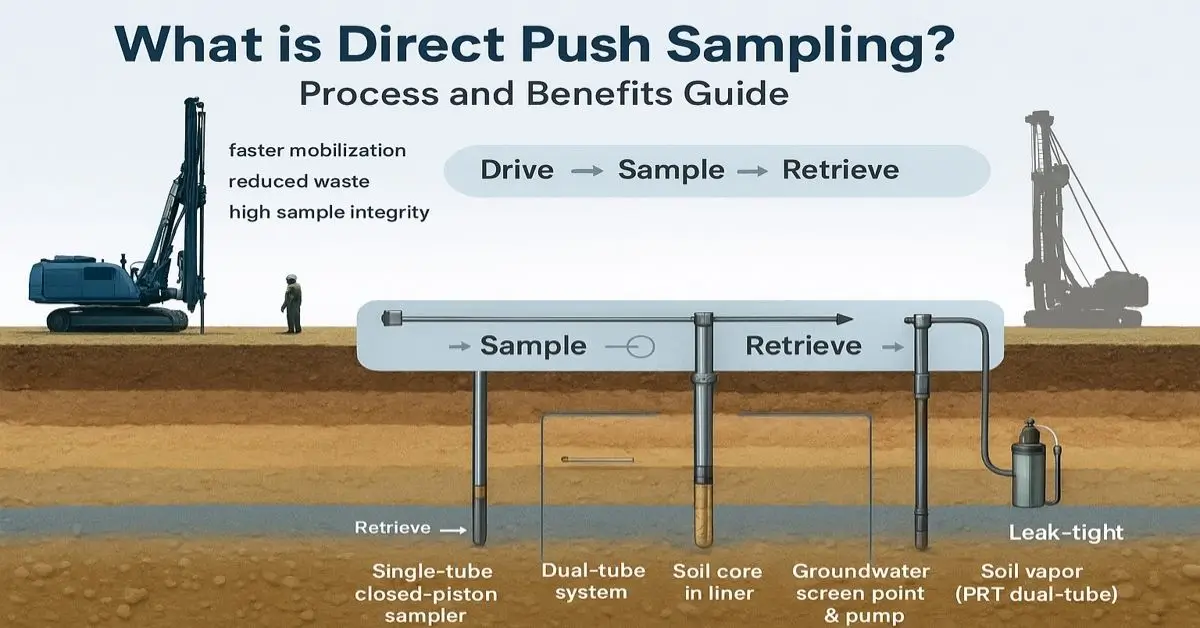Key Intake:
Q1: What is direct push sampling and how does it work?
Direct push sampling uses hydraulic percussion and rig weight to advance sealed samplers into unconsolidated soils. It collects soil, groundwater, and vapor samples without removing drill cuttings. (epa.gov)
Q2: When should I use single-tube vs dual-tube direct push sampling?
Use single-tube closed-piston samplers below water or in heave-prone sands; use dual-tube for continuous core recovery and reduced cross-contamination. Choose by DQOs and formation. (geoprobe.com)
Q3: How deep can direct push drilling reach and what limits penetration?
Penetration depends on rig weight, hammer energy, and soil type. Practical depths often range to tens of meters in unconsolidated soils; rock, cobbles, and dense clays cause refusal.
Q4: How do I collect uncontaminated soil samples with a Geoprobe?
Use sealed liners (PTFE for VOCs), decontaminate tools between locations, and follow ASTM/EPA sampling protocols to maintain chain-of-custody and data integrity.
Q5: Are direct push wells legally acceptable for regulatory monitoring?
Often yes, if installed and grouted per state rules and ASTM guides. Check local regulations; some states restrict small-annulus wells for long-term monitoring.
Overview
Introduction
Direct push sampling answers the consultant’s and regulator’s core need, get defensible subsurface data fast, with low waste and clear QA/QC. This method cuts mobilization time, keeps the footprint small, and often reduces cost compared with rotary drilling. In practice, teams use dual-tube or sealed single-tube systems, combine sensors like MIP/HPT/UVOST, and follow ASTM:/EPA guidance to keep results court-ready.
Instant Answer
Direct push sampling collects sealed soil, groundwater, or vapor samples using hydraulic percussion and rig weight, delivering fast, low-waste site data suitable for environmental and geotechnical decisions (ASTM; EPA).
How Direct Push Sampling Works

Mechanics: Hydraulic hammer + static rig load drive a tool string; samplers collect liners or set screens, enabling continuous cores, groundwater samplers, or vapor probes.
Think of it like a guided punch through loose soils, no rotary bit, no circulating fluids. Operators may use expendable cutting shoes, inner liners, or deploy screen points for water.
This video explains the sampling system of a Geoprobe DT22 soil:
“Geoprobe® DT22 Soil Sampling System“
Understanding Direct Push Drilling
Direct push drilling uses percussion, static weight, and a tool string (Geoprobe, hammer, probe rods) to advance sealed samplers; it avoids cuttings and supports continuous or discrete sampling.
This means you push sampling tools straight into sands, silts, and gravels. It’s faster than rotary in those soils and leaves little investigation-derived waste (IDW). In practice, operators pick rig power and sampler diameter to match site goals.
The Mechanics of Direct Push Technology
Percussive energy (top-drive hammer), static weight, and rod coupling (tool string, center rods) combine to overcome soil resistance and form an annular seal above the target interval.
Hammer energy and vehicle weight determine penetration. In coarse sands you may advance rapidly; in dense clays you may hit refusal. Operators balance impact, feed rate, and rod diameter to optimize recovery.
Components of a Direct Push Rig
Core parts include percussion hammer (top drive), probe rods, outer casing (dual tube), liners (PTFE, PVC, stainless), and ancillary pumps (peristaltic, bladder).
Choose liner material by analyte, PTFE for VOCs, stainless for metals. The drive head and breakout capabilities affect how quickly you trip rods and retrieve samples.
Direct Push Tooling and Sampling Methods

Use single-tube closed-piston samplers for sealed cores below water; dual-tube systems (DT22, DT325) protect the borehole and reduce cross-contamination.
Dual-tube works well for continuous cores and installing pre-packed screens. Closed-piston single-tube samplers give high integrity in fluidized zones. Choose by data quality objectives (DQOs).
There are different sampling methods used some are mentioned below:
1. Soil Core Sampling with Direct Push Equipment
Continuous cores inside liners (1⅛” to 40mm) capture stratigraphy and chemistry while limiting disturbance; splitters enable immediate subsampling for VOCs.
Onsite core splitting lets you send VOC jars quickly and refrigerate samples per SW-846. This reduces volatilization and keeps labs happy.
2.Groundwater Sampling Using Direct Push Systems
Screen points, mill-slotted well points, and peristaltic or bladder pumps let you collect discrete groundwater samples in hours; temporary piezometers can be slug-tested for hydraulic conductivity.
Depth expansion: For quick profiling, use multi-port profilers or deploy screen points at intervals. Make sure to develop screens when installing monitoring wells through casing.
3. Soil Vapor Sampling and the Dual Tube Method
The Post-Run Tubing (PRT) dual-tube setup isolates vapor lines and enables purging and direct sample capture to canisters or Tedlar bags for VOC analysis.
Purge 3 system volumes and verify leak tightness. Passive screened implants serve long-term monitoring when active sampling isn’t feasible.
4. Installing Monitoring Wells with Direct Push Technology
DP rigs can install pre-packed monitoring wells (½”–2″ ID) through outer casing; grout annulus often applied via tremie tube to seal the borehole.
Some regulators limit DP well use due to small annulus. Check local rules before specifying permanent monitoring wells. This method suits many short-term monitoring needs.
Key Benefits of Direct Push Drilling

Direct push sampling delivers fast, low-cost site data, high sample integrity, small footprint, and minimal investigation-derived waste, ideal for rapid site characterization.
You’ll often reduce mobilization time and staff. In many soils, teams hit hundreds of feet per day for reconnaissance; for cores, throughput depends on sampler type.
Limitations of Direct Push Drilling
Direct push works best in unconsolidated formations; it struggles in rock, cemented sands, cobble-rich tills, or very dense clays; refusal and stuck tooling are real risks.
When refusal occurs, consider sonic drilling or rotary coring. Plan for tool extraction forces and contingency mobilization to avoid costly stalls.
Recommended asset: Decision matrix: “Use DP vs Sonic vs Rotary by formation.”
Data Quality, Standards, and Regulatory Compliance
Follow ASTM D6001/D6286 and EPA sampling guidance to meet DQOs; chain-of-custody and decon protocols make DP data defensible for regulators.
Document every step, sampler IDs, liner material, purge volumes, and development methods. Regulators accept DP data when methods and QA/QC align with standards.
Choosing Equipment and Optimizing Performance
Match rig (Geoprobe DT22/DT325/7822DT), hammer energy, and sampler diameter to soil type and DQOs to optimize penetration and sample integrity.
Use PTFE liners for VOCs, stainless for metals. Check rig features, breakout, top-drive hammer, casings, and plan for same-day tooling availability when schedules are tight.
Troubleshooting Common Direct Push Issues
Common issues include formation heave in saturated sands, liner jams from fine sands, and refusal in dense layers; prevention relies on tool selection and advancement technique.
For heave, add water to outer casing or switch to closed-piston single-tube. If liners jam, use lighter rods or reduce feed rate.
Applications and Case Uses
DP sampling supports UST investigations, hazardous site triage, HRSC, and rapid delineation of VOC plumes, often as part of a multi-technique program (MIP + DP cores). (Cloudinary)
Pair MIP or HPT for screening then collect DP cores at hot spots for lab confirmation. This saves lab costs and speeds decisions.
When to Choose Sonic or Rotary Instead?
Choose sonic or rotary when encountering rock, cobbles, refusal, or when large-diameter, Class C/D samples are required for geotechnical testing.
Sonic gets deeper and recovers larger undisturbed samples. Plan budgets and mobilization accordingly, sometimes the extra cost avoids repeated DP refusals.
List of Sources:
- ASTM International: The global benchmark for soil and groundwater testing standards, including ASTM D6282 and D6724 guidelines for direct push sampling and monitoring well installation.
- U.S. Environmental Protection Agency (EPA): Offers regulatory frameworks and best practices through its Guide for Regulators: Direct Push Technologies and related monitoring well studies. Visit EPA Guide
- Environmental Wiki: Provides peer-reviewed insights by Wesley McCall and Tom Christy on the science and evolution of direct push technology. Explore Environmental Wiki
- Interstate Technology & Regulatory Council (ITRC): Delivers modern frameworks for PFAS sampling and analytical methods compatible with DPT operations.
- Geoprobe® Systems: Industry pioneer and equipment innovator, offering advanced solutions for direct push tooling, soil vapor collection, and membrane interface probe systems.
Author Bio
Lena Marlowe is a Senior Field Methods Specialist. Lena has 12 years of practical experience managing direct push, sonic, and geotechnical campaigns across industrial and contaminated sites. She helps teams plan DQO-driven field programs and tooling selection.












